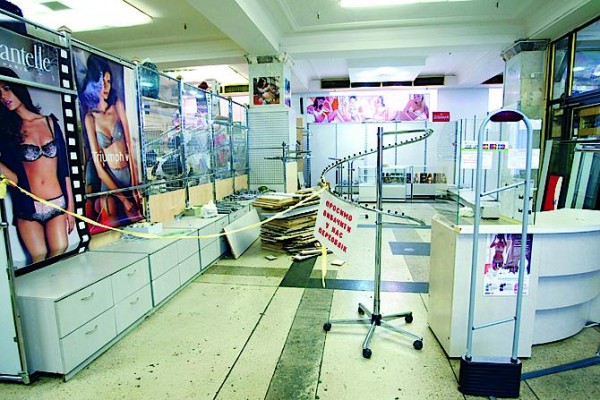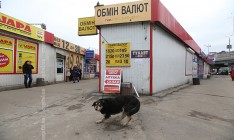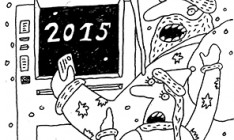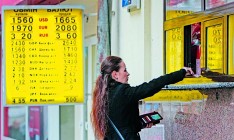Economy
CurrencyOfficials will limit imports to reinforce the hryvnia

The National Bank of Ukraine may appeal to the Ministry of Economic Development and Trade (MEDT) with a recommendation to define the criticality of import, NBU Governor Valeriya Hontareva told the heads of Ukraine’s 40 largest banks at a meeting on Monday, one banker that attended the meeting told Capital.
By outlining the list of imported goods that are critical for the country and toughening the terms of import for other goods, the MEDT should help lower the demand for hard currency on the part of importers. This would ease devaluation pressure on the hryvnia, which since November 5 continues to drastically fall by the day. This would also help the national currency from falling below the benchmark of UAH 16/USD, which the NBU and commercial banks agreed to on Monday. Yesterday, the official exchange rate of the hryvnia to the dollar reached UAH 15.77/USD, while the buy rate on the inter-bank market was UAH 15.80/USD and the sell rate was UAH 16.25/USD.
Echoes from the past
The government of Ukraine actively practiced compilation of the list of goods of critical import that can be brought into the country without paying the VAT back in 1990. After Ukraine acceded to the World Trade Organization, it stopped applying this practice although there were attempts to renew this practice in the most difficult times for the economy. In particular, in the fall of 2008, when the global financial crisis hit, the export of Ukrainian goods hit rock bottom and the Ukrainian currency fell from UAH 4.85/USD to UAH 7.70/USD. Then the Cabinet of Ministers headed by Yulia Tymoshenko considered the possibility of compiling a list of critical import goods and limiting the import of goods into the country that were not on the list. It was planned that oil, gas and petroleum products, cacao beans, palm oil and other raw materials from the food industry, as well as equipment that is not manufactured in Ukraine, should be put on the list. As then Minister of the Economy Bohdan Danylyshyn specified, critical import goods would have customs privileges and would be VAT exempt. It was presumed that such a measure would help reduce the sharply increasing foreign trade deficit and ease the devaluation pressure on the exchange rate of the hryvnia on the part of importers.
Specifically, the National Bank of Ukraine headed by Volodymyr Stelmakh at the time reviewed the possibility of using a differentiation formula for setting the rate for the sale of hard currency for importers of critical and non-critical import goods. In that case, importers of energy resources and equipment could have been granted the right to buy hard currency at the official exchange rate, while the rest would buy it at a less beneficial rate on the inter-bank exchange.
Interestingly, then Chair of the NBU Council Petro Poroshenko supported the idea of limiting import for a year in order to stabilize the situation on the market. However, the critical import initiative was criticized by business circles and therefore was not implemented to the fullest. Instead, the government introduced targeted limitation of imports for specific types of products without privileges for top-priority import goods.
Return of the chosen
Today, there is no list of critical import goods. “Any company that enters the foreign market and buys toothpaste can have an influence on the hard currency exchange rate from which all average citizens suffer,” Chairman of the Board of the Ukrainian Interbank Currency Exchange Anatoliy Hulei pointed out. In his opinion, the government should develop criteria and priorities for critical import.
By the way, there are more contras than pros to this initiative. “The ban on imports of the majority of commodities will have a short-term positive effect on the balance of trade, but in the long run this will lead to the formation of a shadow market for imported goods, which will take years to eliminate,” Head of the Analytical Department of SP Advisors Vitaliy Vavryshchuk noted.
In addition to that, it is difficult to define which categories of goods are critical for import. For example, it is not clear whether all machine-building products should be categorized as critical for import or light-weight automobiles should be excluded from this list. Even if the list of priority products will be compiled without the influence of lobbyists, the results of this initiative will be a sharp surge of inflation. Moreover, as Vavryshchuk pointed out, this will happen not even after limitations are introduced, rather in expectation of their introduction, seeing as Ukrainian consumers may run to the stores to quickly buy up household appliances and companies may buy raw material reserves.
Nevertheless, the NBU could once again take such a radical measure if exporters do not return their earnings to the country and increase the supply of hard currency outside of the inter-bank exchange in the foreseeable future. Regardless of the fact that the import of goods and services into the country fell by 24% in the period January-September due to the devaluation of the hryvnia, the current volumes on the inter-bank exchange are not sufficient to cover all the needs of importers and of the banks that are experiencing an outflow of hard currency deposits and the pressure of peoples’ demand for hard currency. Indeed, US $7.5 bn in foreign currency were sold on the inter-bank exchange in September, while the volume of imports was US $6 bn. Meanwhile, importers cannot count on the hard currency auctions, as their volume in a new format is limited to US $10 bn per day.






 of the agreement of syndication with Financial Times Limited are strictly prohibited. Use of materials which refers to France-Presse, Reuters, Interfax-Ukraine, Ukrainian News, UNIAN agencies is strictly prohibited. Materials marked
of the agreement of syndication with Financial Times Limited are strictly prohibited. Use of materials which refers to France-Presse, Reuters, Interfax-Ukraine, Ukrainian News, UNIAN agencies is strictly prohibited. Materials marked  are published as advertisements.
are published as advertisements.